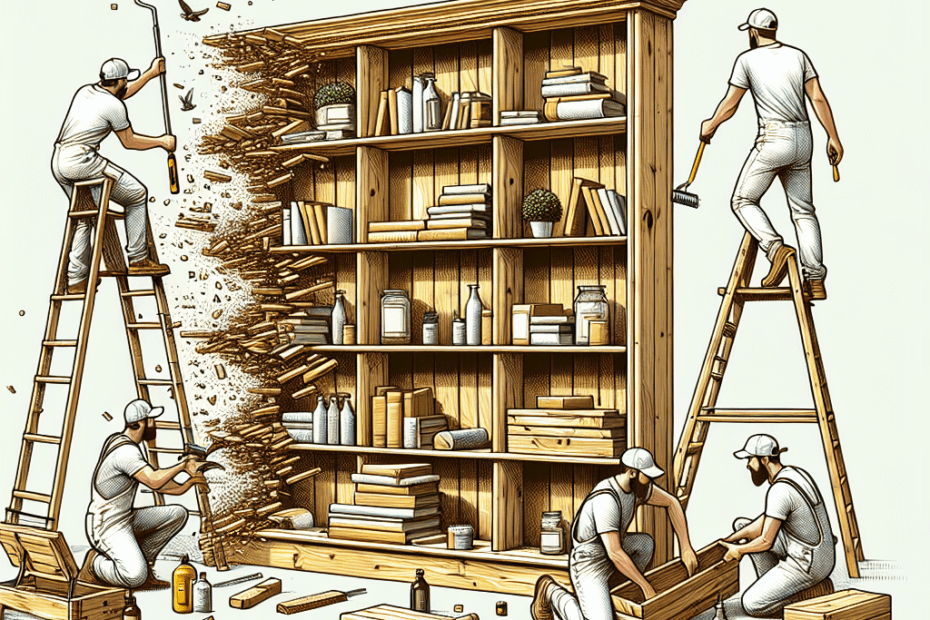“`html
Introduction
Many individuals find themselves seeking creative ways to combine functionality with sustainability in their homes. One increasingly popular option is to build a DIY Reclaimed Wood Bookshelf. By repurposing materials, they not only reduce waste but also bring a piece of history into their living spaces. For those who appreciate rustic charm and enjoy hands-on projects, learning how to build a bookshelf from reclaimed wood can be both rewarding and eco-friendly.
Why Choose Reclaimed Wood?
Reclaimed wood offers unique benefits that new wood cannot match. It provides an authentic, rustic look due to its aged and weathered appearance. According to a report by The Woodworking Network, using reclaimed wood can reduce the carbon footprint by 30-50% compared to using new lumber. The distinct character of reclaimed wood includes natural imperfections and varying wood grains, which add depth and interest to furniture pieces.
The Benefits of DIY Projects
Building a bookshelf from reclaimed wood allows individuals to customize their design according to their specific space and needs. Personal projects like this save money—purchasing new furniture can be costly—and they can often be completed using recycled materials found locally or even from personal supplies.
Materials and Tools Needed
Creating a reclaimed wood bookshelf requires gathering the right materials and tools. Essential items include:
- Reclaimed wood planks
- Sandpaper or a power sander
- Wood screws or nails
- Saw
- Measuring tape
- Wood stain or sealant (optional)
With these tools in hand, one can create a sturdy and stylish bookshelf that will stand the test of time.
Step-by-Step Guide to Building the Bookshelf
- Plan and Measure: Determine the size and shape of the bookshelf. A standard bookshelf might be 6 feet tall with three shelves, but measurements can vary based on needs and available space.
- Prepare the Wood: Before starting, inspect and clean the reclaimed wood. Remove nails, sand the surface to smooth out rough edges, and cut the wood to the desired length.
- Assemble the Shelves: Begin by constructing the frame. Attach the planks for each shelf using nails or screws, and ensure everything is level and sturdy.
- Secure the Structure: Once the shelves are built, attach supports or brackets to ensure stability. Pay attention to corner joints and add additional support if the wood is particularly aged or thin.
- Finish the Surface: Optionally, apply a wood stain or sealant to protect the bookshelf from wear and maintain the reclaimed wood’s natural beauty.
Potential Challenges and Solutions
While crafting a DIY Reclaimed Wood Bookshelf is an enjoyable endeavor, challenges can arise. Uneven wood surfaces may require extra care during sanding. It is crucial to check for hidden nails or screws, which can damage tools if not removed beforehand. Additionally, old wood can splinter, so wearing protective gloves and eyewear is recommended during construction.
Here is a simple overview of common challenges and solutions:
| Challenge | Solution |
|---|---|
| Uneven surfaces | Sand thoroughly and consider using a planer for extreme cases. |
| Hidden nails/screws | Use a metal detector before cutting or sanding. |
| Splinters | Wear protective gear and sand edges properly. |
| Lack of uniform wood sizes | Get creative with design and embrace the uniqueness. |
Key Takeaways
- Building a bookshelf with reclaimed wood is both sustainable and cost-effective.
- Reclaimed wood has unique aesthetic qualities that are unattainable with new materials.
- Planning and measuring are critical steps to ensure the bookshelf fits the desired space.
- Overcoming challenges such as uneven surfaces requires patience and proper tools.
Conclusion
Incorporating a DIY Reclaimed Wood Bookshelf into their home not only reduces environmental impact but also allows the builder to express creativity and craftsmanship. By selecting reclaimed wood, individuals support sustainability and enjoy the character and story that aged wood provides. With care, a homemade bookshelf from reclaimed planks becomes a functional piece of art that houses books, decorations, and memories.
FAQ
- Can anyone build a reclaimed wood bookshelf?
Yes, with patience and the right tools, anyone interested in DIY projects can build a bookshelf. - What is the cost benefit of using reclaimed wood?
Reclaimed wood is often cheaper than new lumber and reduces the project’s overall cost while being environmentally friendly. - Where can they find reclaimed wood?
Reclaimed wood can be sourced from old buildings, barns, or through local suppliers and online marketplaces specializing in recycled materials. - How do they ensure the bookshelf is stable?
Proper planning, using sturdy materials for supports, and securing joints well are key to a stable bookshelf. - Is it necessary to finish the wood?
While not necessary, finishing the wood with a sealant or stain can both protect it and enhance its visual appeal.
“`
